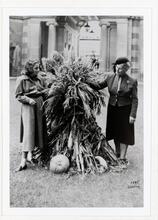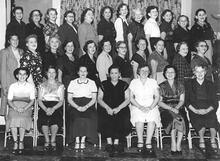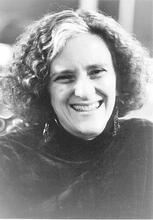Mathilde Schechter
Mathilde Schechter.
Courtesy of CJ: Voices of Conservative/Masorti Judaism.
Mathilde Schechter was born in Prussia and moved to England to study in London, where she met and married Solomon Schechter. In 1902 the family moved to the United States. In addition to literary pursuits and editing all of her husband’s writings, she established a vocational school for Jewish girls and organized the Society for Ancient Hebrew Melodies. The crowning achievement of her career was founding the Women’s League for Conservative Judaism, which became one of the largest Jewish women’s organizations in the United States. She was a multifaceted individual, creative both in her home and in the public arena. As an organizational person, she developed herself fully, in line with the traditional women’s roles of the times yet stretching them in new and creative ways.
Background
Mathilde Roth Schechter, founder of the Women’s League for Conservative Judaism and the wife of Solomon Schechter, the well-known Jewish scholar, was born in Guttentag, a small town in Silesia, and orphaned at an early age.
Little is known about her parents or family background. Indeed, she exemplifies the difficulties of learning about the wives of famous men, frequently women of talent, who are overshadowed by their better-known spouses. Like so many women of her day, her energy was expended primarily in the private sphere, and thus the task of reconstructing her life is difficult. Despite the fact that she was intent on creating a life rather than building an empire, she founded what became one of the largest Jewish women’s organizations in the United States.
Having grown up in the Jewish home for orphans in Breslau, Mathilde was educated in local schools and attended the Breslau Teacher’s Seminary. Home to a thriving Jewish community, Breslau was also the site of the Jewish Theological Seminary, an eminent scholarly and rabbinical institution. After teaching in Breslau for a number of years, Mathilde moved to England to study at Queens College in London and to “read in the treasures of the British Museum, the National Gallery and the endless private collections.” In 1887, she met and married Solomon Schechter, the Jewish scholar who discovered the large cache of ancient Jewish manuscripts in a Cairo synagogue. The collection became known as the Cairo Geniza.
The Schechter Family
The Schechter home quickly became the center of the young intellectual Jewish elite in London. Mathilde Schechter’s hospitality was legendary and she maintained her reputation when the couple moved to Cambridge and later to the United States. She had a strong Jewish identity and contributed significantly to the Jewish community. While her husband taught at Cambridge and traveled around Europe and the Middle East collecting manuscripts, Mathilde Schechter brought up their three children, edited the works of local scholars, and engaged in various literary pursuits, including a translation of the Jewish poet Heinrich Heine. Furthermore, she edited almost everything her famous husband wrote and is primarily responsible for the felicitous English style of his essays.
In 1902, the Schechter family came to America when Solomon Schechter was appointed president of the Jewish Theological Seminary in New York. Again the Schechter home became an intellectual center for a diverse group of people. Henrietta Szold in writing to Frank Schechter later described the Schechter home and “those full vivid days when she [Mathilde Schechter] and your father and your house were a stimulating creative center, in whose genial warmth we—so many, many of us—basked and were transformed.”
Career
Mathilde Schechter pursued serious interests outside the home. She established a Jewish vocational school for girls on the Lower East Side, which not only prepared young women for the world of work but also helped to strengthen their Jewish identity. Her musical talent and interest in congregational singing (new at that time) led to the organization of a Society for Ancient Hebrew Melodies as well as the publication of a hymn book titled Kol Rina—Hebrew Hymnal for School and Home. The crowning achievement of her public career was the establishment of the Women’s League of the United Synagogue of America (today called the Women’s League for Conservative Judaism). The United Synagogue, organized by Solomon Schechter a few years before his death in 1915, was designed to include all types of synagogues. However, it virtually marked the beginning of the Conservative Movement in America. The establishment of the Women’s League was a way for Mathilde Schechter to pay tribute to her husband. The league was at first a constituent body of the United Synagogue, but Mathilde Schechter strongly advocated its autonomy, lest “the organization be swallowed into the United Synagogue entirely.” The Women’s League, whose chapters were within the synagogue, expanded quickly, and within a few years there were thirty-four chapters all over the country.
One of the first projects of the Women’s League was the establishment in 1918 of a Student House in the Columbia University area that served as a center for Jewish students as well as for Jewish soldiers and sailors on leave. The concept of a Student House was a true expression of Mathilde Schechter’s values as a caretaking person. It fulfilled an important function as a recreational and cultural center before the existence of the B’nai B’rith Hillel university system.
Speaking on Mother’s Day 1919, at Mordecai Kaplan’s Jewish Center in New York, Mathilde Schechter stressed the “absolute unselfishness and utter forgiveness of mother-love,” at the same time emphasizing the needs of mothers to retain a sense of themselves apart from their maternal role. She believed strongly in the power of Judaism to soothe and to comfort. The A biblical or rabbinic commandment; also, a good deed.mitzvot [commandments] and especially the rituals were indeed “the song of our soul’s communion with God.” Defending the ancient idea of ritual, she eloquently stated her belief that “a living religion needs the spirit and the red-blooded warmth of forms, forms tenderly kissed into life by the spirit.”
Mathilde Schechter lived in an age when domesticity was the ideal for women. She was a multifaceted individual, creative both in her home and in the public arena. As an organizational person, she developed herself fully, in line with the traditional women’s roles of the times yet stretching them in new and creative ways.
Mathilde Schechter died in August 1924.
AJYB, 27:151.
NYTimes, August 28, 1924, 17:5.
Scult, Mel. “The Baale Boste Reconsidered: The Life of Mathilde Roth Schechter (M.R.S.).” Modern Judaism 7 (February 1987): 1–29.










